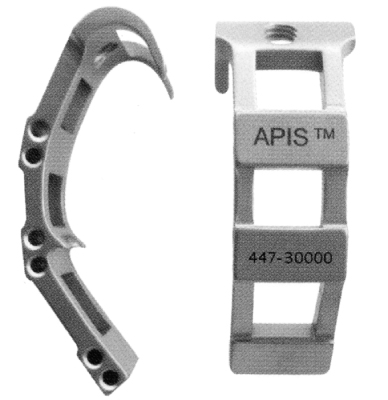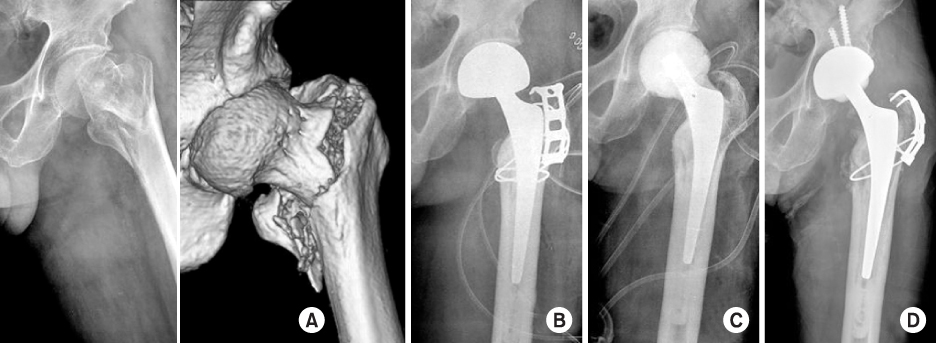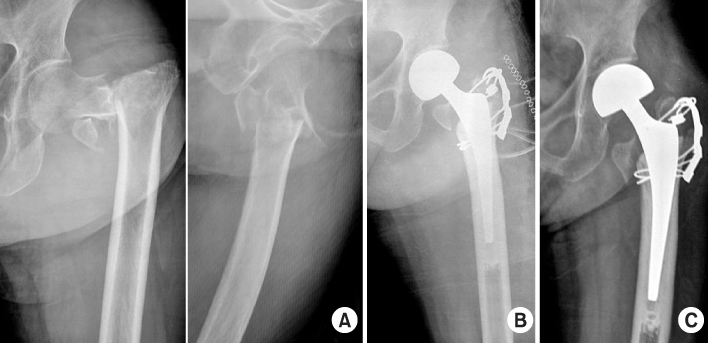J Korean Fract Soc.
2009 Oct;22(4):232-238. 10.12671/jkfs.2009.22.4.232.
Bipolar Hemiarthroplasty Using the Greater Trochanter Reattachment Device (GTRD) for Comminuted Intertrochanteric Femur Fracture in Elderly Patients
- Affiliations
-
- 1Department of Orthopedic Surgery, Busan Medical Center, Busan, Korea. dro1973@nate.com
- KMID: 1469988
- DOI: http://doi.org/10.12671/jkfs.2009.22.4.232
Abstract
- PURPOSE
To evaluate the clinical and radiological outcome of the greater trochanter reattachment device (GTRD) as firm fixation method for displaced greater trochanter fragment in bipolar hemiarthroplasty for comminuted intertrochanteric femur fracture in elderly patients. MATERIALS AND METHODS: From January 2006 to January 2008, 32 patients above 70 years old treated with bipolar hemiarthroplasty using the GTRD as fixation method for comminuted intertrochanteric femur fracture with greater trochanter bone fragment displaced above 1 cm. They were followed up for more than one year. Clinically, the postoperative Harris hip score (HHS) and daily activities of life of Johnston et al were evaluated, and radiological, any displacement of greater trocharter bone fragments and/or GTRD. RESULTS: The mean postoperative HHS was 71.6 (range, 53~82) points. In rating the daily activity of life, twenty seven (84.4%) patients` postoperative results were above fair. Two patients (6.3%) had displacement of the greater trochanter bone fragment above 1 cm. One patient had a deep infection, so we removed the bipolar head and inserted antibiotics-loaded cement block instead, and after the infection was controlled, conversion to total hip arthroplasty was done. CONCLUSION: In bipolar hemiarthroplasty for comminuted intertrochanteric femur fracture with displaced greater trochanter bone fragment, GTRD produced satisfactory results and early rehabilitation.
Keyword
Figure
Reference
-
1. Bonamo JJ, Accettola AB. Treatment of intertrochanteric fractures with a sliding nail-plate. J Trauma. 1982; 22:205–215.
Article2. Boyd HB, Graffin LL. Classification and treatment of trochanteric fractures. Arch Surg. 1949; 58:853–866.
Article3. Chan KC, Gill GS. Cemented hemiarthroplasties for elderly patients with intertrochanteric fracture. Clin Orthop Relat Res. 2000; 371:206–215.
Article4. Donnelly WJ, Kobayashi A, Freeman MA, et al. Radiological and survival comparison of 4 methods of fixation of a proximal femoral stem. J Bone Joint Surg Br. 1997; 79:351–360.5. Gill JM, Johnson GR, Sher JL, Korrjoccan NA. Biomechanical aspects of the repair of intertrochanteric fractures. J Biomed Eng. 1989; 11:235–239.
Article6. Haentjens P, Casteleyn PP, De Boeck H, Handelberg F, Opdecam P. Treatment of unstable intertrochanteric and subtrochanteric fractures in elderly patients. Primary bipolar arthroplasty compared with internal fixation. J Bone Joint Surg Am. 1989; 71:1214–1225.
Article7. Haentjens P, Casteleyn PP, Opdecam P. Primary bipolar arthroplasty of total hip arthroplasty for the treatment of unstable intertrochanteric and subtrochanteric fractures in elderly patients. Acta Orthop Belg. 1994; 60:Suppl 1. 124–128.8. Hamadouche M, Zniber B, Dumaine V, Kerboull M, Courpied JP. Reattachment of the ununited greater trochanter following total hip arthroplasty. The use of a trochanteric claw plate. J Bone Joint Surg Am. 2003; 85:1330–1337.
Article9. Harper MC. The treatment of unstable intertrochanteric fractures using a sliding screw-medial displacement technique. J Trauma. 1982; 22:792–796.
Article10. Harris WH. Traumatic arthritis of the hip after dislocation and acetabular fractures: treatment by mold arthroplasty. An end-result study using a new method of result evaluation. J Bone Joint Surg Am. 1969; 51:737–755.
Article11. Jensen JS, Sohne-Holm S, Tondevold E. Unstable trochanteric fractures. A comparative analysis of four methods of internal fixation. Acta Orthop Scand. 1980; 51:949–962.
Article12. Johnston RC, Fitzgerald RM Jr, Harris WH, Poss R, Müller M, Sledge CB. Clinical and radiographic evaluation of total hip replacement. A standard system of terminology for reporting results. J Bone Joint Surg Am. 1990; 72:161–168.
Article13. Kho DH, Shin JY, Kim KH, Lee JH, Kim DH. Trochanteric management for unstable intertrochanteric femoral fracture in the elderly patients. J Korean Fract Soc. 2007; 20:129–134.
Article14. Kim WY, Han CH, Ji JH, Kim YY, Lee KS, Lee SW. Fixation for reattachment of trochanteric fragment in pertrochanteric fracture treated with bipolar hemiarthroplasty. J Korean Hip Soc. 2006; 18:67–72.
Article15. Koyama K, Higuchi F, Kubo M, Okawa T, Inoue A. Reattachment of the greater trochanter using the Dall-Miles cable grip system in revision hip arthroplasty. J Orthop Sci. 2001; 6:22–27.
Article16. Lestrange NR. Bipolar arthroplasty for 496 hip fractures. Clin Orthop Relat Res. 1990; 251:7–19.
Article17. Stern MB, Goldstein TB. The use of the leinbach prosthesis in intertrochanteric fractures of the hip. Clin Orthop Relat Res. 1977; 128:325–331.
Article18. Yoon ES, Min HJ, Suh JS, et al. Comparison of clinical results between bipolar hemiarthroplasty and compression hip screw on unstable intertrochanteric fractures of the femur in elderly patients. J Korean Fract Soc. 2004; 17:214–220.
Article
- Full Text Links
- Actions
-
Cited
- CITED
-
- Close
- Share
- Similar articles
-
- Fixation of Greater Trochanter Using an AO Trochanteric Reattachment Device (AO TRD) in Arthroplasty for Intertrochanteric Femur Fracture of Elderly Patients
- Modified Double Tension Band Wiring for Reattaching the Greater Trochanter When Performing Hemiarthroplasty for Intertrochanteric Fracture in Elderly Patients
- Fixation for Reattachment of Trochanteric Fragment in Pertrochanteric Fracture Treated with Bipolar Hemiarthroplasty
- Treatment of Intertrochanteric Fracture in Elderly Patients with Preservation of Calcar Femorale and Hemiarthroplasty
- Primary Bipolar Hemiarthroplasty Compared with Compression Hip Screw on Treatment of Elderly Unstable Intertrochanteric Fractures





